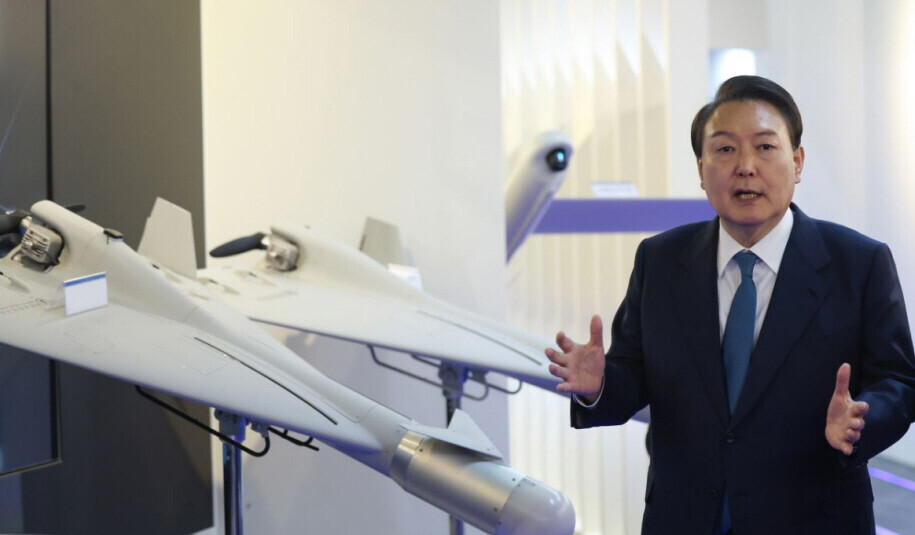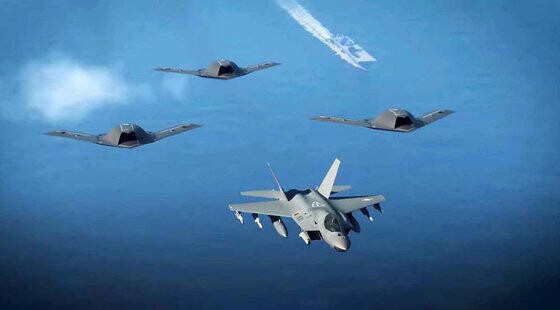hankyoreh
Links to other country sites 다른 나라 사이트 링크
After S. Korea’s drone defense shield fails, Yoon goes on the offensive

After North Korean drones infiltrated the airspace of South Korea’s capital region on Dec. 26, a South Korean Army corps dispatched two RQ-101 Night Intruder drones on a reconnaissance flight in North Korean airspace five kilometers beyond the Military Demarcation Line. The conservative press reported that South Korean President Yoon Suk-yeol, after being briefed about the incursion by North Korean drones, ordered the military to send two or three times as many drones into the North.
While some South Korean commentators took satisfaction in the fact that the South Korean military had responded to North Korea’s drone incursion with an incursion of its own, the move also raised serious concerns.
For one thing, tit-for-tat of this sort is a poor look for the Yoon administration, given its policy objective of making Korea a “global pivotal state.” While the Yoon administration has emphasized compliance with international norms, sending drones north of the Military Demarcation Line is a violation of the Armistice Agreement.
Following the North Korean drone incursion, the UN Command — which is in charge of ensuring compliance with the Armistice Agreement — has been investigating whether the two sides have violated the deal. In effect, Yoon’s decision to send drones North has become one of the issues being investigated by the UN Command.
It’s also unclear what military advances South Korea can gain by sending drones north of the armistice line, as explained by a general in the Air Force Reserve who spent a large part of his career working with airplanes and drones.
“North Korea resorted to a drone incursion because it doesn’t have spy satellites or advanced reconnaissance aircraft. What’s the point of sending tactical surveillance drones north when we can already take high-resolution photos of anywhere in the North?” the reserve general asked.

The South Korean military has both long-distance surveillance assets and high-altitude surveillance aircraft, both manned and unmanned, as complementary methods of surveilling North Korea. The Baekdu and Geumgang surveillance aircraft are capable of detecting signals intelligence as far as Mount Paektu (Baekdu) and imagery intelligence as far as the area north of Mount Kumgang (Geumgang).
South Korea also operates four Global Hawks, high-altitude surveillance drones that can spot objects on the ground with a diameter as small as 30 centimeters from 20 kilometers in the air. In addition, US spy satellites monitor all of North Korea.
The Night Intruder drones that were sent into North Korean airspace on Dec. 26 have an operational radius of 80 kilometers and a flight duration of around six hours. In wartime, Night Intruders would be responsible for monitoring the battle situation and enemy movements, spotting targets for artillery units, and assessing damage.
Given its capabilities and missions, the Night Intruder wouldn’t normally need to be sent to North Korea for reconnaissance purposes.
After a North Korean drone was found in South Korea in April 2014, when Park Geun-hye was president, her administration reportedly weighed the option of sending drones into North Korea. But officials didn’t send the drones out of concern about the fallout from violating the armistice agreement and the possibility of drone technology being leaked if a drone were to crash in North Korean territory.
As a response to the North Korean drones, the Yoon administration announced plans to quickly establish a joint drone headquarters to perform multipurpose duties including surveillance, reconnaissance, and electronic warfare. It also declared plans to produce stealth drones and small-scale drones within the year.
In response to the MND’s announcement of its response measures on Wednesday, some raised the question of why the administration was only discussing offensive measures when the issue concerned a breach of its air defense network.
A military official replied, “While it is correct that the defensive role should be considered first, it is difficult to defend against drones with equipment of a [purely] defensive nature.”
At the time, the MND did not explain whether the joint drone headquarters would be a functional headquarters in charge of indirect support or a combat headquarters directly executing combat duties.
The plan apparently is to create the unit first without any basic regulations, at a time when troops and combat units have been shrinking due to population decline.
Within the military, the Air Force and Army are watching closely to see what happens with the joint drone headquarters’ authority for managing air space.
People have also been voicing concern over Yoon assigning a year-end deadline for developing stealth drones. The MND has said it is possible to produce them within the year using Agency for Defense Development (ADD) technology.
But at the time the Defense Acquisition Program Administration (DAPA) presented a video on the domestically produced Kaori stealth drone fighter in October 2021, military officials gave a stealth drone development completion date of 2033. Producing the drones within the year would mean moving the original development timetable up by 10 years.
Beyond the acquisition of more drones and anti-aircraft weaponry, the situation is one that requires measures to address holes in the military’s air defense network command system.
The ROK Army I Corps, which oversees northern Gyeonggi Province, did not transmit intelligence about the North Korean drones to the Capital Defense Command on Dec. 26. The system now is one where the Army is in charge of low-altitude anti-aircraft weapons such as anti-aircraft guns in the greater Seoul area (the 20mm Vulcan and 30mm Biho), while the Air Force is in charge of medium- and high-altitude weapons consisting of various anti-aircraft missiles.
The Air Force Operations Command oversees Air Force tactical control systems for responding to North Korean drones, while the Army Aviation Operations Command controls Army stealth helicopters. Observers have raised the need to establish a more integrated anti-aircraft system.
In an advisory text sent to reporters Sunday, the Joint Chiefs of Staff acknowledged that there had been “some deficiencies in cooperation and sharing of the situation between the I Corps [which first detected the drones on Dec. 26] and the Capital Defense Command.”
By Kwon Hyuk-chul, staff reporter
Please direct questions or comments to [english@hani.co.kr]

Editorial・opinion
![[Column] Park Geun-hye déjà vu in Yoon Suk-yeol [Column] Park Geun-hye déjà vu in Yoon Suk-yeol](https://flexible.img.hani.co.kr/flexible/normal/500/300/imgdb/original/2024/0424/651713945113788.jpg) [Column] Park Geun-hye déjà vu in Yoon Suk-yeol
[Column] Park Geun-hye déjà vu in Yoon Suk-yeol![[Editorial] New weight of N. Korea’s nuclear threats makes dialogue all the more urgent [Editorial] New weight of N. Korea’s nuclear threats makes dialogue all the more urgent](https://flexible.img.hani.co.kr/flexible/normal/500/300/imgdb/original/2024/0424/7317139454662664.jpg) [Editorial] New weight of N. Korea’s nuclear threats makes dialogue all the more urgent
[Editorial] New weight of N. Korea’s nuclear threats makes dialogue all the more urgent- [Guest essay] The real reason Korea’s new right wants to dub Rhee a founding father
- [Column] ‘Choson’: Is it time we start referring to N. Korea in its own terms?
- [Editorial] Japan’s rewriting of history with Korea has gone too far
- [Column] The president’s questionable capacity for dialogue
- [Column] Are chaebol firms just pizza pies for families to divvy up as they please?
- [Column] Has Korea, too, crossed the Rubicon on China?
- [Correspondent’s column] In Japan’s alliance with US, echoes of its past alliances with UK
- [Editorial] Does Yoon think the Korean public is wrong?
Most viewed articles
- 1‘We must say no’: Seoul defense chief on Korean, USFK involvement in hypothetical Taiwan crisis
- 2N. Korean delegation’s trip to Iran shows how Pyongyang is leveraging ties with Moscow
- 3Amnesty notes ‘erosion’ of freedom of expression in Korea in annual human rights report
- 4‘Weddingflation’ breaks the bank for Korean couples-to-be
- 5[Reportage] On US campuses, student risk arrest as they call for divestment from Israel
- 6[Column] Park Geun-hye déjà vu in Yoon Suk-yeol
- 7Korea sees more deaths than births for 52nd consecutive month in February
- 8Will NewJeans end up collateral damage in internal feud at K-pop juggernaut Hybe?
- 9[Guest essay] The real reason Korea’s new right wants to dub Rhee a founding father
- 10[Editorial] New weight of N. Korea’s nuclear threats makes dialogue all the more urgent